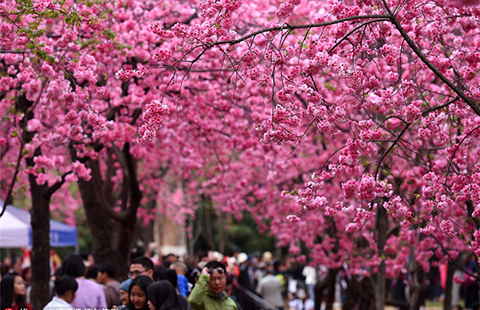Wedding businesses need tweak, report says
Updated: 2016-08-26 07:16
By ZHOU WENTING(China Daily)
|
||||||||

Search platform advises more customized services for couples, focus on smaller cities
China's wedding industry should shift to more customized services, as the number of people getting married is decreasing, a market report said on Wednesday.
The industry enjoyed explosive growth in the past, partly because of the large marriage-age population. The number of couples tying the knot will be less than 10 million in 2020, down from 13.5 million in 2013, the high point after several years of growth since 2010, according to the 2016 Blue Book of the Marriage Market by Meituan-Dianping, an online-to-offline service platform.
The decline in Beijing and Shanghai is most obvious, the blue book said.
The number of people born annually after 1990 is lower than previous years. For example, data from the Ministry of Civil Affairs shows roughly 15 million babies were born in the country in 1996, a drop of 10 million from a decade previously.
Compounding the puzzle, the younger generation is postponing marriage.
However, while the marrying group is getting smaller, the price that prospective brides and grooms pay for each element of the process-a wedding banquet, portraits, renting a wedding gown-is on the rise, as is the total turnover of the industry, according to the report.
"Customers are not attracted by inexpensiveness," said Yang Feng, general manager of the wedding business department of Meituan-Dianping, which provides people with search results of 120,000 service providers in the marriage industry. "They are willing to pay more for high-quality service and experience-especially custom services."
Newlyweds in Beijing pay an average of 260,000 yuan ($39,100) on marriage celebrations, which usually include wedding rings, flowers, wedding photography and a banquet with decorations. Some brides even purchase or rent three or four wedding gowns, the report said.
The average outlay in Shanghai is 200,000 yuan. The national average is just under 100,000 yuan.
The report also said businesses should further develop the market in small cities, as the ratio of people from those regions searching online for wedding services is rising.
The report noted that Henan, Guizhou and Yunnan provinces, as well as the Guangxi Zhuang autonomous region, will likely present the best potential for development.
Huang Jianing, a Shanghai native, held two wedding feasts in June-one in Shanghai and the other in Chengdu, Sichuan province, her husband's home. She said it cost more than 11,000 yuan for a table at a five-star hotel in Shanghai, but a table at the same standard in Chengdu cost 2,500 yuan.
- Bolivian deputy interior minister killed by miners: report
- In photos: Great Dorset Steam Fair 2016
- Historical towns before and after Italy's earthquake
- Car bomb kills at least eight at police headquarters in Turkey
- Brazil's Senate begins Rousseff's impeachment trial
- Arts festival aims to unite cultures

 World's top 10 largest banks by assets
World's top 10 largest banks by assets
 Sand sculptures to welcome the G20 Summit
Sand sculptures to welcome the G20 Summit
 Historical towns before and after Italy's earthquake
Historical towns before and after Italy's earthquake
 College prepares 300 sleeping mats for parents
College prepares 300 sleeping mats for parents
 Ten photos from around China: Aug 19 – 25
Ten photos from around China: Aug 19 – 25
 Top 5 fitness bands in customer satisfaction
Top 5 fitness bands in customer satisfaction
 Orangutan goes shopping in Southwest China
Orangutan goes shopping in Southwest China
 Prince William and Kate visit charity orgarnization
Prince William and Kate visit charity orgarnization
Most Viewed
Editor's Picks

|

|

|

|

|

|
Today's Top News
Trump outlines anti-terror plan, proposing extreme vetting for immigrants
Phelps puts spotlight on cupping
US launches airstrikes against IS targets in Libya's Sirte
Ministry slams US-Korean THAAD deployment
Two police officers shot at protest in Dallas
Abe's blame game reveals his policies failing to get results
Ending wildlife trafficking must be policy priority in Asia
Effects of supply-side reform take time to be seen
US Weekly

|

|







